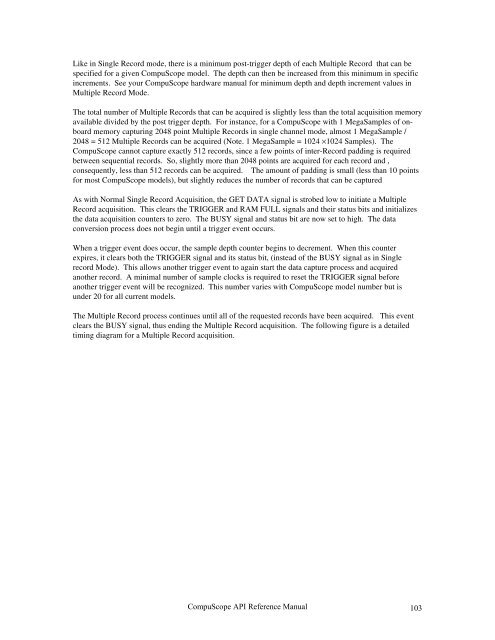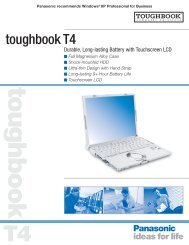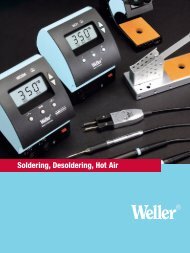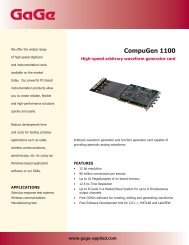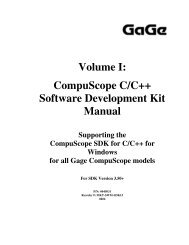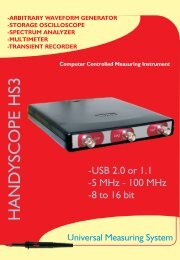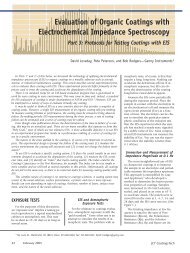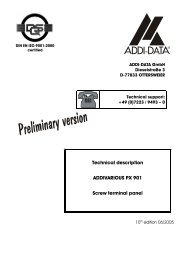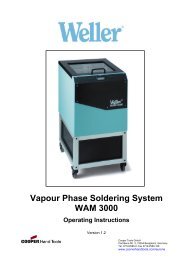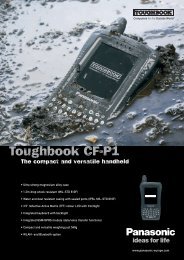CompuScope SDK Manua.. - Egmont Instruments
CompuScope SDK Manua.. - Egmont Instruments
CompuScope SDK Manua.. - Egmont Instruments
Create successful ePaper yourself
Turn your PDF publications into a flip-book with our unique Google optimized e-Paper software.
Like in Single Record mode, there is a minimum post-trigger depth of each Multiple Record that can be<br />
specified for a given <strong>CompuScope</strong> model. The depth can then be increased from this minimum in specific<br />
increments. See your <strong>CompuScope</strong> hardware manual for minimum depth and depth increment values in<br />
Multiple Record Mode.<br />
The total number of Multiple Records that can be acquired is slightly less than the total acquisition memory<br />
available divided by the post trigger depth. For instance, for a <strong>CompuScope</strong> with 1 MegaSamples of onboard<br />
memory capturing 2048 point Multiple Records in single channel mode, almost 1 MegaSample /<br />
2048 = 512 Multiple Records can be acquired (Note. 1 MegaSample = 1024 ×1024 Samples). The<br />
<strong>CompuScope</strong> cannot capture exactly 512 records, since a few points of inter-Record padding is required<br />
between sequential records. So, slightly more than 2048 points are acquired for each record and ,<br />
consequently, less than 512 records can be acquired. The amount of padding is small (less than 10 points<br />
for most <strong>CompuScope</strong> models), but slightly reduces the number of records that can be captured<br />
As with Normal Single Record Acquisition, the GET DATA signal is strobed low to initiate a Multiple<br />
Record acquisition. This clears the TRIGGER and RAM FULL signals and their status bits and initializes<br />
the data acquisition counters to zero. The BUSY signal and status bit are now set to high. The data<br />
conversion process does not begin until a trigger event occurs.<br />
When a trigger event does occur, the sample depth counter begins to decrement. When this counter<br />
expires, it clears both the TRIGGER signal and its status bit, (instead of the BUSY signal as in Single<br />
record Mode). This allows another trigger event to again start the data capture process and acquired<br />
another record. A minimal number of sample clocks is required to reset the TRIGGER signal before<br />
another trigger event will be recognized. This number varies with <strong>CompuScope</strong> model number but is<br />
under 20 for all current models.<br />
The Multiple Record process continues until all of the requested records have been acquired. This event<br />
clears the BUSY signal, thus ending the Multiple Record acquisition. The following figure is a detailed<br />
timing diagram for a Multiple Record acquisition.<br />
<strong>CompuScope</strong> API Reference <strong>Manua</strong>l<br />
103


